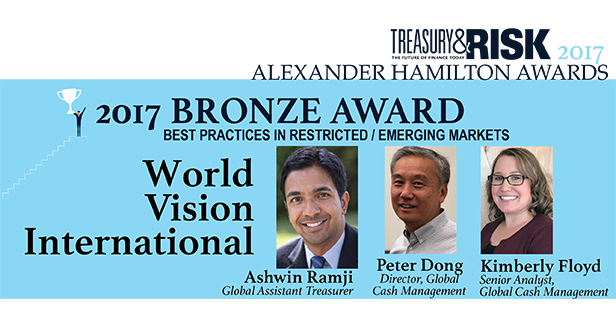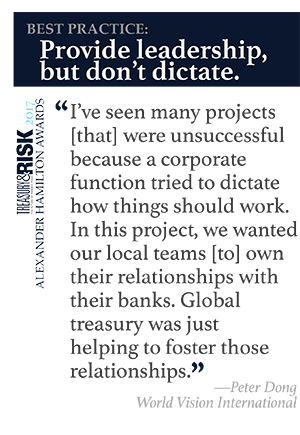 World Vision International is committed to doing good around the world, and doing it in a big way. The organization, which has annual revenue of nearly US$3 billion, operates in remote and rural areas within about 100 different countries.
World Vision International is committed to doing good around the world, and doing it in a big way. The organization, which has annual revenue of nearly US$3 billion, operates in remote and rural areas within about 100 different countries.
“We are a child-focused organization,” explains Ashwin Ramji, the global assistant treasurer for WVI. “We work with communities to identify what work is needed to improve the well-being of vulnerable children in those communities, then we commit to long-term projects that meet those needs. We may go in for 10 to 15 years with projects that focus on education, water and sanitation, irrigation, or housing—whatever the local community needs.” WVI funds these projects through child sponsorship and other donation programs.
In addition, Ramji says, “working with communities and our partners, we are advocates for child well-being outcomes, both at the U.N. and in our work with local governments. For example, we are very active throughout Southeast Asia in advocating against child slavery and sex trafficking.”
Operational decision-making in this environment tends to be decentralized. “When you're targeting specific communities in remote areas, you can't really make the operational decisions from headquarters,” Ramji says. This approach makes sense, but it can create challenges for support functions such as treasury and finance.
 “We operate in many locations where the banking structure is weak or even nonexistent,” reports Peter Dong, WVI's director of global cash management. “At one point, World Vision was using more than 200 banks, and properly managing the controls on all those accounts was unwieldy. Given the external emphasis on KYC [Know Your Customer] and sanctions compliance issues, it made sense for us to start centralizing many of our banking functions.”
“We operate in many locations where the banking structure is weak or even nonexistent,” reports Peter Dong, WVI's director of global cash management. “At one point, World Vision was using more than 200 banks, and properly managing the controls on all those accounts was unwieldy. Given the external emphasis on KYC [Know Your Customer] and sanctions compliance issues, it made sense for us to start centralizing many of our banking functions.”
First, global treasury used an RFP process to select eight large banks that were financially stable, had strong correspondent banking networks, offered the right mix of cash management products and services, and had a global footprint similar to WVI's. To ensure that each banking relationship encompassed as broad a geographical reach as possible, the organization grouped most of the countries in which it operates into “clusters” and instructed the banks to bid on clusters rather than on individual countries. This prevented the banks from cherry-picking only the most desirable markets. For example, in order to win WVI's business in high-value Kenya, a bank would also have to be competitive in countries such as Somalia and South Sudan.
The RFP process was time-consuming but worthwhile. WVI was able to divvy up the banking business for 58 of its 67 offices among the eight participating banks. “The bank rationalization project excluded only countries like Ethiopia and Nicaragua,” Ramji explains. “These are markets in which only very local banks can operate.”
Next, the organization undertook the “solutioning” phase of the bank rationalization, with multiple goals in mind. “Obviously, we wanted to reduce the number of banking relationships and the number of accounts we had,” says Kimberly Floyd, WVI's senior analyst, global cash management, who served as project lead. “We also wanted to convert payments from cash and check to electronic formats as much as possible, in order to improve efficiency for our staff. We wanted the banks to have a contingency process in place to help ensure that business would continue even in a disaster scenario. And in countries where it was feasible, we asked the banks to provide employee benefits.”
Finally, Dong adds, WVI aimed to implement cash management discipline throughout its operations around the globe. “We worked with our banks to ensure that we have the most efficient cash management system in place in each region, whether that means a ZBA [zero-balance accounts] structure, interest optimization, or taking advantage of payments-related services.”
Each bank that won a cluster of business through the RFP process matched members of its own local staff with select local WVI employees. Together, they performed extensive due diligence on the payment and cash requirements for each country within the bank's cluster. “The WVI staff who would ultimately be using the services were the liaisons to the banks, as the banks were trying to craft solutions,” Dong says. “For more than two years, these liaisons met with their banks on a weekly basis. We asked the banks to resolve any cash management issues our staff was having difficulty with. In some cases, their answer was that they couldn't do exactly what we requested, but they would come up with an alternative solution. Transparency was crucial in both directions, and this extensive communication was the key to success.”
WVI global treasury had to overcome several challenges before achieving this free-flowing communication. “Challenges included everything from language barriers to cultural differences to inconsistencies in the meaning of certain cash management terms,” Floyd says. “In some cases, we had miscommunications around products, services, and capabilities simply because staff came from different cultural and educational backgrounds. We overcame these types of challenges by making sure we had a communication line that was always available.”
To that end, Floyd and global treasury analyst Michael Lawson served as global project managers who were available to answer questions from either banks or local WVI staff.
“I've seen many projects like this, from the perspective of both the bank and the nonprofit organization,” Dong says. “Many were unsuccessful because a corporate function tried to enter each country and dictate how things should work. In this project, we wanted to make sure our local teams would own their relationships with their banks, and global treasury was just helping to foster those relationships.”
Now the 58 WVI offices that participated in this project have consolidated their accounts into eight banks, down from the 200 the organization used previously. Global treasury estimates that this consolidation is saving World Vision between $10 million and $15 million per year by reducing fees charged on unnecessary accounts, reducing staff resources required to manage myriad banking relationships, and increasing WVI's negotiation position by having banks bid on clusters of countries at once.
“Some of the countries that World Vision operates in are difficult,” Ramji says. A system that works smoothly, so that contractors are paid on time, helps ensure the safety and security of the organization's field operations.
 “It's important to have the global treasury function at the center of a project like this,” Dong adds. “Treasury understands what the banks can provide. The treasury team should also understand what banking products the organization's local operations require.
“It's important to have the global treasury function at the center of a project like this,” Dong adds. “Treasury understands what the banks can provide. The treasury team should also understand what banking products the organization's local operations require.
“For World Vision, the bank rationalization project has raised the profile of the global treasury team because the project touched so many parts of the organization,” Dong concludes. “Now when other groups within World Vision have an upcoming project, they may come to us and ask how that project will impact their banking relationships. Or they may have a need for funding and come to treasury to find out where that funding can come from. The organization now sees treasury as a strategic partner.”
2017 Alexander Hamilton Awards — Best Practices in Restricted/Emerging Markets
- Gold: Honeywell | Opening the Credit Umbrella in China
- Silver: Pfizer | Transition to the CNY
© Touchpoint Markets, All Rights Reserved. Request academic re-use from www.copyright.com. All other uses, submit a request to [email protected]. For more inforrmation visit Asset & Logo Licensing.


